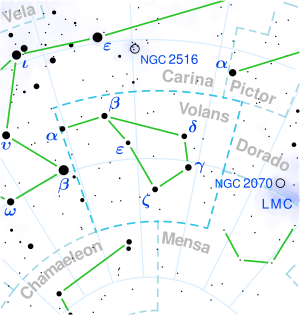HD 76920
Location of HD 76920 (circled)
Observation dataEpoch J2000.0[ 1] Equinox J2000.0[ 1]
Constellation
Volans
Right ascension 08h 55m 16.81719s
Declination
−67° 15′ 55.7009″
Apparent magnitude (V)7.82[ 2]
Characteristics
Evolutionary stage
Red-giant branch star [ 3]
Spectral type
K1 III[ 3]
B−V color index
1.11[ 2]
J−H color index
0.537[ 4]
J−K color index
0.693[ 4]
Astrometry Radial velocity (Rv )20.09 ± 0.14[ 5] Proper motion (μ) RA: 25.253[ 6] mas /yr Dec.: 25.659[ 6] mas /yr Parallax (π)5.4618 ± 0.0187 mas [ 6] Distance 597 ± 2 ly pc ) Details[ 3] Mass ± 0.11M ☉ Radius ± 0.34R ☉ Luminosity +1.3 [ 7] L ☉ Surface gravity (log g )± 0.037cgs Temperature ± 53K Metallicity ± 0.06dex Rotational velocity (v sin i )± 0.3[ 7] Age ± 1.4Gyr Other designations CD −66° 659,
CPD −66° 943,
Gaia DR2 5224124307320401024,
HD 76920,
HIP 43803,
SAO 250379,
PPM 357010,
TIC 302372658,
TYC 8939-1192-1,
GSC 08939-01192,
2MASS J08551682-6715555[ 1] Database references SIMBAD data
HD 76920 is a solitary[ 8] exoplanetary companion in the southern constellation of Volans , close to the border with Carina . With an apparent magnitude of 7.82, it is too faint to be seen by the naked eye from Earth but is readily observable through binoculars .[ 9] Gaia EDR3 parallax measurements, and is moving away at a heliocentric radial velocity of 20.09 km/s.
Stellar properties
This is an aging giant star with a stellar classification of K1 III. At the age of ± 1.4evolved past the main sequence after depleting its hydrogen supply at the core . It is currently in the midst of ascending the red-giant branch (RGB), fast approaching the RGB bump, where deep stellar convection temporarily stalls the ascent. As expected of RGB stars, it exhibits solar-like oscillations . It has 1.22 times the mass of the Sun but has expanded to 8.68 times the Sun's radius .[ 3] luminosity of the Sun from its inflated photosphere at an effective temperature of 4,664 K (4,391 °C; 7,936 °F).[ 7]
Planetary system
In 2017, radial-velocity observations made using spectrographs at the Anglo-Australian Telescope , the Cerro Tololo Inter-American Observatory , and the MPG/ESO telescope revealed the existence of an exoplanet around HD 76920.[ 8] eccentric Jupiter with a minimum mass of 3.57 M J [ 3] orbital eccentricity of 0.8782,[ 7] scattering event rather than Kozai oscillations .[ 8]
Because of its high eccentricity, despite an Earth-like semi-major axis of 1.165 AU and a period of 415.891 days (1.13865 years), the planet approaches the star to within 2.4 stellar radii at its perihelion .[ 7] orbital decay ; thus the planet is expected to survive for the next 50–80 million years without falling into the star.[ 7] tidal interactions will doom it to be engulfed.[ 3]
The planet has a relatively high probability (16%) to transit its host star, but such a transit has yet to be detected by TESS .[ 7]
See also
References
^ a b "HD 76920" . SIMBAD Centre de données astronomiques de Strasbourg . Retrieved 23 December 2024 .^ a b Høg, E.; Fabricius, C.; Makarov, V. V.; et al. (February 2000). "The Tycho-2 Catalogue of the 2.5 Million Brightest Stars". Astronomy and Astrophysics . 355 (1): L27 – L30 . Bibcode :2000A&A...355L..27H . ^ a b c d e f g Jiang, Chen; Wu, Tao; Feinstein, Adina D.; et al. (1 March 2023). "TESS Asteroseismic Analysis of HD 76920: The Giant Star Hosting an Extremely Eccentric Exoplanet" . The Astrophysical Journal . 945 (1): 20. arXiv :2302.01102 Bibcode :2023ApJ...945...20J . doi :10.3847/1538-4357/acb8ac ISSN 0004-637X . ^ a b Cutri, Roc M.; Skrutskie, Michael F.; Van Dyk, Schuyler D.; et al. (2003). "VizieR Online Data Catalog: 2MASS All-Sky Catalog of Point Sources (Cutri+ 2003)". CDS/ADC Collection of Electronic Catalogues . 2246 : II/246. Bibcode :2003yCat.2246....0C . ^ Brown, A. G. A. ; et al. (Gaia collaboration) (August 2018). "Gaia Data Release 2: Summary of the contents and survey properties" . Astronomy & Astrophysics 616 . A1. arXiv :1804.09365 Bibcode :2018A&A...616A...1G doi :10.1051/0004-6361/201833051 Gaia DR2 record for this source at VizieR .^ a b c Brown, A. G. A. ; et al. (Gaia collaboration) (2021). "Gaia Early Data Release 3: Summary of the contents and survey properties" . Astronomy & Astrophysics 649 : A1. arXiv :2012.01533 Bibcode :2021A&A...649A...1G . doi :10.1051/0004-6361/202039657 S2CID 227254300 . (Erratum: doi :10.1051/0004-6361/202039657e ) . Gaia EDR3 record for this source at VizieR .^ a b c d e f g h i Bergmann, C.; Jones, M. I.; Zhao, J.; et al. (2021). "HD 76920 b pinned down: A detailed analysis of the most eccentric planetary system around an evolved star" . Publications of the Astronomical Society of Australia . 38 . arXiv :2102.08902 Bibcode :2021PASA...38...19B . doi :10.1017/pasa.2021.8 ISSN 1323-3580 . ^ a b c Wittenmyer, Robert A.; Jones, M. I.; Horner, Jonathan; et al. (1 December 2017). "The Pan-Pacific Planet Search. VII. The Most Eccentric Planet Orbiting a Giant Star" . The Astronomical Journal . 154 (6): 274. arXiv :1711.05378 Bibcode :2017AJ....154..274W . doi :10.3847/1538-3881/aa9894 ISSN 0004-6256 . ^ Zarenski, Ed (2004). "Limiting Magnitude in Binoculars" (PDF) . Cloudy Nights. Archived (PDF) from the original on 21 July 2011. Retrieved 6 May 2011 . ^ "HD 76920 b - NASA Science" . Retrieved 23 December 2024 .
